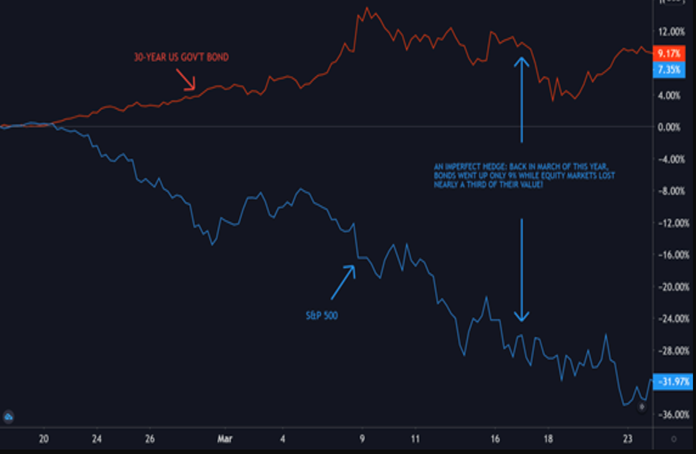Why a Flood of Capital is Set to Flee Gov’t Bonds for Bitcoin and Gold

Government bonds are no longer the hedge against falling stock prices as they once were.
And this is a big problem for pension funds, insurance companies and other big-footprint investment companies.
These institutional investors have roughly $100 trillion in assets. Of that, usually about 70% is invested in equities for growth and capital appreciation, with 30% in in government bonds — as a hedge, in case stocks go down the tube, or worse.
This 70:30 portfolio allocation has been standard practice for a long time.
Problem is … the hedge doesn’t work anymore.
That’s because decades of hyper-growth in world debt markets.
That plus massive money-printing to prevent them from collapsing … has totally changed the financial landscape.
After inflation, gov’t bond yields are near (or below) zero — and will continue to be for the foreseeable future.
Even before subtracting inflation, yields are already near-zero or negative. As a result, the classic bond hedge is now broken.
How Hedging with Bonds Failed
During March’s Stock Market Panic
 |
| Comparative performance of 30-year U.S. Treasuries vs. the S&P 500 Index — late February to late March. Click to enlarge. |
As you can see, back in March when pandemic lockdowns knocked stocks into a tailspin, bonds initially moved up. But their rise was only one third the decline in stocks.
And since the classic 70:30 hedge has only 30% in bonds, it was only able to offset about 10% of the portfolio losses. At that rate, the next market rout could ruin investors in a big hurry.
What’s gone wrong?
Well for one thing, central banks have all but killed government bond markets. They basically buy up and hoard such an overwhelming share of available supplies, which means most private-sector buyers are crowded out.
In fact, central bank buying has so monopolized the bond market that the very term,“market” is itself becoming an anachronism.
What Bond Market? Where?
Gosh, instead of suing Facebook for being a monopoly, federal authorities should sue the Federal Reserve for monopolizing what once was once the most important, liquid market on the planet — the U.S. government bond market!
Large fund managers are acutely aware of this. So, they’re starting to divest away from government bonds, replacing them with alternative safe havens like precious metals and crypto assets.
As we write, roughly $30 trillion is sitting in government bonds. Suppose 10% of that amount finds its way into gold and Bitcoin. That works out to an exodus of $3 trillion. And if that is split evenly, we’d end up with …
- $1.5 trillion going into gold — which is 15% of gold’s market cap (now about $10 trillion). And …
- $1.5 trillion going into Bitcoin — which is 4.4 times its market cap (now about $338 billion).
Due to Bitcoin’s much lower market cap and trading volume, it has the potential to rise far faster than gold … as new money from disillusioned bond investors pours in.
A Second Reason Bitcoin Will Likely Go Up Faster than Gold
Bitcoin has a hard ceiling on total coin supply. No more than 21 million BTC will ever be produced. This is hard-wired into the blockchain.
Gold supplies, however, are not similarly constrained.
Instead, higher prices enable miners to develop lower-grade deposits that were previously uneconomic to produce. And this increment to supply works against rapidly rising prices.
Bottom line: Bitcoin is still a relatively small asset class. So even relatively small capital inflows can have a very big impact on prices.
As an investor, why not put this kind of built-in leverage to work? Look for pullbacks to buy Bitcoin before it starts to soar.
Best,
Juan and Bruce

